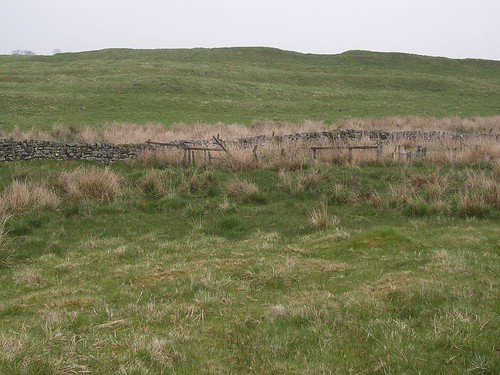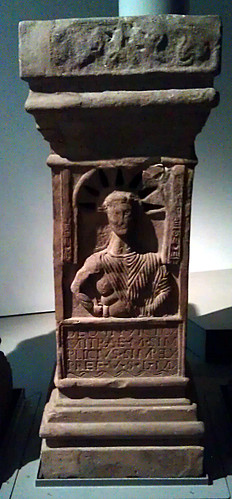Wall Mile 31 [HB 215 and 224]
Our gentle climb continues until we reach Carraw Farm, where we are diverted off to the north (this bit can get a bit plodgy) and then back round and onto the upcast mound again, north of the ditch. Now, however, since we have passed the crest, Carrawburgh fort heaves into view south of the road, after we have negotiated the dip. You will have noted that, now that the Wall has come down from the crags, it is being extremely well-behaved and traversing the landscape with nice straight stretches, just like the Vallum has been doing all along. Now there is nothing to stop the two of them running along, hand-in-hand, for a few miles.

Carrawburgh from near Carraw Farm
Our second crossing of the Military Road is about to occur, but here there is no pedestrian crossing as there was in Stanwix so keep a sharp lookout as they drive fast around these parts and the crossing is at the bottom of the dip.

Site of Coventina’s Well
Once over the road, there is an extremely boggy portion off to the right of the path (between us and the imposing ramparts of the fort) and the section with a pond in the middle of it is in fact the site of the shrine of Coventina, a local water nymph. When it was excavated in 1876, it produced vast amounts of coins (more than 13,000; some were melted down and cast into a bronze eagle – must have seemed like a good idea at the time) as well as other votive material, some of which we can see in Chesters museum very soon, and is characteristic of the Celto-Roman veneration of water deities.
Carrawburgh fort (BROCOLITIA) [HB 216–23]

Carrawburgh fort (BROCOLITIA) (pronounced Carra-Bruff) is 7.6km (4.75 miles) from Housesteads and is one of the forts that sits astride the Wall, rather than attached to the rear or even detached. Occupying 1.6ha (3.9 acres), it was constructed after the Vallum, the course of which runs under it. It was garrisoned by the cohors I Aquitanorum in the 2nd century and other units attested include the cohortes I Cugernorum, I Frixiavonum, and I Tungrorum (the last of which, as we know from Housesteads, was milliary, so only a detachment would have fitted in). Cohors I Batavorum was recorded in the 3rd and 4th centuries.

Mithraeum
There is little to see of the fort, although its platform is still prominent, but the mithraeum outwith the fort in the civil settlement is on display. When excavated, the waterlogged conditions preserved many organic remains that enabled a detailed reconstruction to be built in the former Museum of Antiquities, now recreated as a rather-less-successful video display in the Great North Museum, both in Newcastle. On site, the organic components have been cast in concrete, which is also the medium employed for the replica statuary and altars.
Designed to mimic a cave and produce what excitable marketing types would probably call ‘an immersive experience’ these days, devotees entered at the south end of this small quasi-apsidal building, encountering a diminutive lobby or vestibule, separated from the rest of the interior by a wooden screen. Beyond the screen were two wicker-lined benches, one on either side, attended by Mithras’ familiar torch-bearing companions Cautes and Cautopates (the former with his torch held upwards, the latter downwards). Cautes has lost his head, but of poor old Cautopates, only the feet remain. At the northern end, there are three altars, dedicated by commanders of the cohors I Batavorum. The one on the left incorporates a nice little effect, whereby the radiate crown of Mithras has been pierced, enabling a lamp to be placed behind it for some minimalistic visual trickery. Evidence of what went on in here includes burnt pine cones, a chicken’s head, and bones from pork, lamb, and more chickens: obviously somebody’s idea of a fun night out in the vicus. The whole thing was thoroughly trashed in the 4th century AD and it is speculated that Christians may have been responsible.

Altar for Mithras
Mithraism was an elitist cult (the temple could only accommodate twelve so it was obviously not meant for the common soldiery), with a strict hierarchy that mimicked the army’s rank structure, and a series of ordeals beloved of such institutions
Immediately outside the entrance at the western end of the mithraeum was another small shrine, dedicated to the nymphs (unsurprising, given the presence of so much water in the vicinity) and the genius loci (literally ‘spirit of the place’).
As we have already seen, the remains of Coventina’s shrine lie nearby, but there was also a bath-house on this side of the fort, excavated by Clayton but not now visible… well, in fact, to be brutally honest, it is currently ‘lost’.
Milecastle 31 (Carrawburgh) [HB 215; haiku]

Looking towards the site of Milecastle 31
Milecastle 31 (Carrawburgh) lay just beyond the eastern end of the car park, part of one of the robbed walls having been found. Needless to say, there is nothing to be seen now.
































You must be logged in to post a comment.